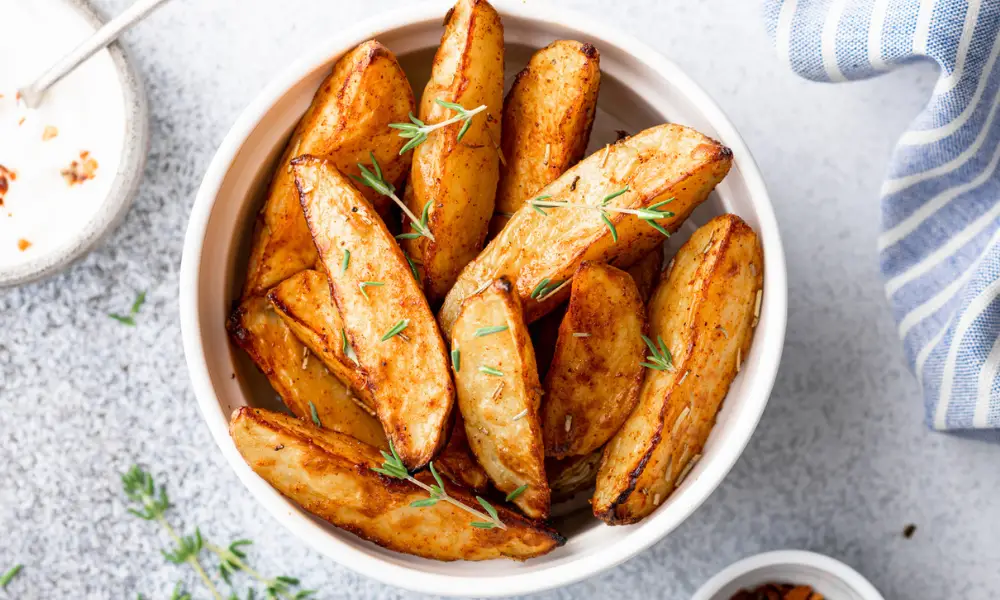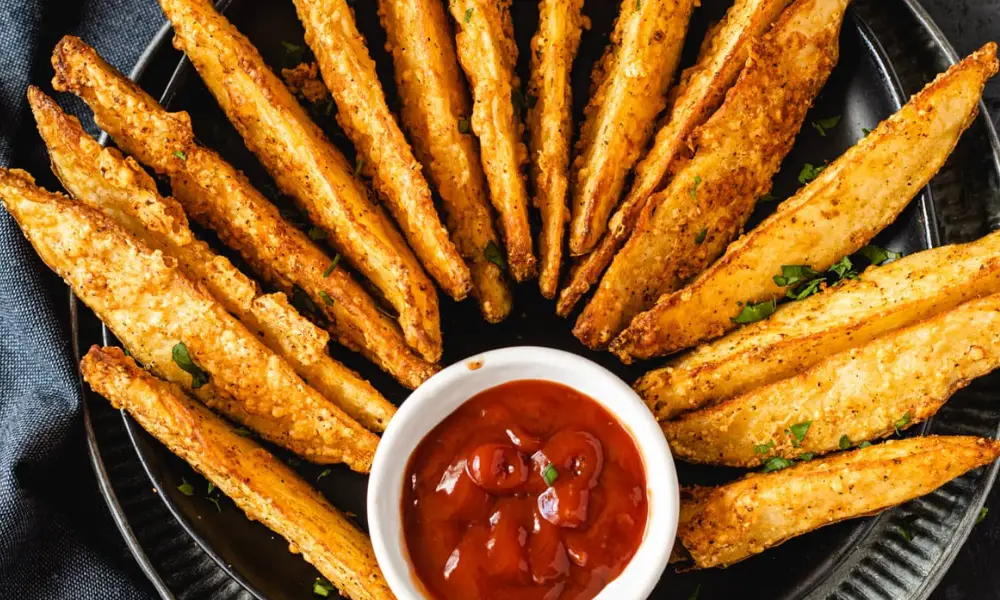Long-term storage of potatoes at room temperature might cause them to spoil. Store them in the fridge to avoid this. You can reheat them in the microwave or an air fryer if you haven’t eaten them for a few days. You may reheat potato wedges using an air fryer and microwave options. These suggestions will help you reheat frozen potato wedges.

What are Potato Wedges?
A tasty and convenient way to obtain your daily allotment of potatoes is with potato wedges. They pair well with most main dishes or as an appetizer with a dip. Then, you may cook these potato slices in various methods, such as deep-frying or browning them in the oven at high heat. Be inventive when using these fries.
Potassium, calcium, iron, and vitamin C are all abundant in potatoes. To help you feel satisfied for longer, potatoes also contain fiber.
How to Reheat Potato Wedges?
It’s simple to prepare and consume potato wedges as a snack. They can be eaten simply or with salt, but the crispiness of the oven makes them ideal for dipping sauces. There are several ways to reheat potato wedges, but figuring out which one would suit everyone the best can be difficult. You’ll learn a couple of simple and delectable techniques in this blog post.
- You want to keep the potato wedges’ delicate, crispy skin when reheating them. As a result, you’ll have to give up on using the microwave and reheat them in either the oven or a heated skillet.
- The best thing to do with day-old wedges is to bake them on a baking sheet. The wedges should be baked for ten to fifteen minutes after the oven has been preheated to 300 degrees Fahrenheit.
- For more flair, you could choose to bake them for the first twelve minutes on the middle rack before transferring them to the top rack.
- For one to two minutes, switch from bake to broil mode to add a little extra crispiness to the wedges.
- Alternatively, you can reheat the wedges on a covered skillet for five to ten minutes, turning them over halfway through.
- More moisture will be retained when using a saucepan with a lid instead of baking them.
Using an Oven
The oven is a great kitchen appliance for reheating leftovers. It keeps the food’s crispy texture because the temperature of the heated air circulating inside is typically higher than that of other appliances.
- This method will function best if you have access to a convection oven because of the internal fan that more effectively distributes heat, producing a crispier outer layer.
- However, conventional ovens also function admirably as long as you periodically check on them during warming.
- Preheat the oven to between 300 and 450 degrees Fahrenheit.
- Brush some oil or butter on the potatoes, paying special attention to those big wedges.
- They should be arranged on the baking sheet on aluminum foil. Do not forget to distribute the potatoes evenly.
- Wait another five minutes for a crispier outer side after they have warmed up for at least ten.
- Flip them over about 50% of the time.
- Please turn off the oven when you notice the golden crisp and wait a few minutes before removing the food.
- The food is now fit for consumption.
- To prevent a soggy outer layer and flavor loss, it’s crucial not to cover your snack with aluminum foil or plastic wrap while baking.
Using an Air Fryer
Unquestionably among the greatest ways to reheat seasoned potato wedges! Your snack will have the perfect amount of crispy crunch when you use an air fryer, and they’re wonderful for folks who don’t like to over-oil their food because they don’t need it.
- Whatever potato meal you prepare, using an air fryer can give it the desired golden crispiness and up the flavor.
- For around two minutes, preheat the air fryer at 220°C.
- Put your potatoes in the basket after removing them.
- Fry them for 10 minutes at 220 C., maintaining the temperature. You should set the timer for 15 minutes if your meal is frozen.
- Check to see if they are golden on both sides before removing them; if not, repeat the process for an additional 2 minutes.
- As soon as they are heated, use them.
This kitchen equipment is so quick and effective that we adore using it. Because you don’t need to defrost the frozen wedges, it also works incredibly well for reheating them.
Using a Microwave
We adore microwaves because of their usefulness, particularly when we need to reheat leftovers. However, microwaves retain moisture in our food, so that this method won’t provide a crispy snack.
If you don’t mind having rather sloppy and gooey wedges, microwaving them will be the quickest method!
- Spread the potatoes out evenly and put them on a big dish that can go in the microwave.
- On their exterior, rub some melted butter or extra virgin olive oil. Nothing should be placed on top of the dish!
- When the machine has been running for around two to three minutes, select the Reheat mode (or high heat level).
- To determine whether they are heated enough to change the heating time, you must keep a close eye on them during the procedure.
- When finished, keep the microwave door open and wait a minute before removing the dish.
- Serve immediately.
- Your initial thought could be to microwave some food to reheat it. It occasionally works, but it depends on the meal. If microwaved, this fast food might not turn out so well.
- Remember that you can improve their flavor by adding various seasoning blends.
Using a Skillet
Using a skillet is a fantastic option if none of the kitchen appliances listed above are in your home.
Because the potatoes are previously cooked, you can fry them without using as much oil and still get that wonderful crispiness, and the potatoes come out less oily.
- It would also be wise to avoid thawing them before reheating. The additional moisture from the defrosting procedure makes your snack excessively mushy and soggy, and the oil will splatter.
- To preheat, place the pan on the stovetop over medium heat.
- About one tablespoon of cooking oil should be added to the pan; allow the oil to boil.
- Spread the potatoes on the pan equally, then turn them over every minute or so until both sides are brown.
- After taking the potatoes out of the pan and placing them on a platter, line a dish with kitchen paper to absorb any excess oil.
- Although it requires some patience and culinary know-how, this technique enables the snack to stay crispy on the outside while being wonderfully warm and fluffy on the inside.
- Make sure not to use too much seasoning or spice if you do add any during this procedure, as it could cause the wedges to cling together.
Tips
- The easiest approach to ensure that your potato wedges maintain their crispness after warming is to arrange them on a baking sheet with a spoonful of oil sprinkled on top.
- Defrosting is unnecessary if you reheat the snack in an oven, microwave, or air fryer. But thawing them ahead will cut down on time needed for reheating.
- Never leave them outside for longer than two hours once they have warmed up. Use them right away.
How to Store Leftover Potato Wedges?
Wedge-shaped potatoes might be difficult to store. It is crucial to use the right container and seal it properly when storing them to prevent them from absorbing moisture from its surroundings and to preserve all of their flavors.
For this task, some people will use a zipper-lock bag or an airtight food storage container with a lid; if there are no other options, others choose to use plastic wrap.
As soon as the leftover wedges have cooled, store them. Wedge leftovers in the fridge for 3 to 4 days by placing them in an airtight jar lined with paper towels. Additionally, wedges may be frozen and kept in freezer bags for up to six months.
They typically keep for up to four days when kept in the fridge or for two weeks when frozen. Use your best judgment when determining the storage period because storage times vary depending on how long they have been left out at room temperature.
Cooked french fries should be refrigerated in shallow airtight containers to extend their shelf life for quality and safety, or they can be securely wrapped in heavy-duty aluminum foil or plastic wrap. Cooked French fries will keep in the refrigerator for 3 to 5 days if properly refrigerated.
What is the Best Way to Reheat Potato Wedges?
Potato wedges or any other meal using potatoes can be heated in the oven. You may maintain the crisp outside of your snack and enjoy it as much as the first time if you reheat it in the oven.
The air fryer is your second choice for cooking potatoes because it keeps them soft on the inside while giving them a slightly crispier exterior than a microwave or skillet.
It’s similar to deep-frying them in a small amount of oil to prevent them from making you feel greasy and full.
How Long do Wedges Last?
The setting in which you store them will determine how long this fast food will last:
Two hours is the greatest time they can spend outside at room temperature. They won’t go bad, but they don’t taste or have the same texture and could easily turn into bacterial growth dishes.
If you securely seal them in the plastic container and store them in the cool refrigerator, they can last for four days. The wedges and frozen meals both have a six-month shelf life.
How to Thaw Wedges?
Before reheating, let frozen cooked potato wedges out on the counter to thaw for an hour or two. Alternately, place them in the refrigerator to thaw for a few hours. Before warming your wedges, pat them down with a dry paper towel to eliminate any extra moisture.
The wedges won’t crisp up nicely if they are damp when you want to reheat them. Don’t refreeze them after they have been defrosted because they won’t keep as well, will lose their moisture, and may begin to represent a health risk.
Can You Reheat Potato Wedges the Next Day?
The best thing to do with day-old wedges is to bake them on a baking sheet. The wedges should be baked for ten to fifteen minutes after the oven has been preheated to 300 degrees Fahrenheit. For more flair, you could choose to bake them for the first twelve minutes on the middle rack before transferring them to the top rack.
Conclusion
A tasty and simple side dish to make is potato wedges. Any meal of the day, including breakfast with eggs, lunch on their own, and night as a side dish with steak, can feature them. We have assembled four distinct methods for reheating potato wedges with the assistance of skilled chefs. Each approach has advantages and disadvantages that vary depending on your liking for the texture or flavor. Pick the option that you believe will work best for you.
